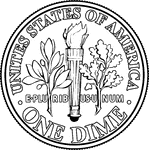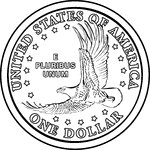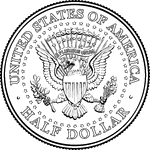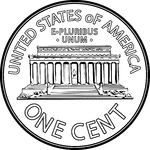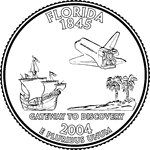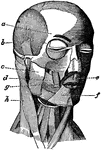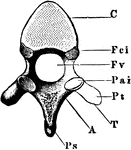
Arytenoid Cartilages of the Larynx
Arytenoid cartilages of the larynx. These are pitcher-like cartilages that are 2 in number, pyramidal-shaped,…

The Kidney
The basic structure of the kidney, which consists of the cortical portion, the medullary substance,…

Dorsal Vertebra
A dorsal vertebra. Labels: 1, the body; 2, face for the head of a rib; 3, superior face of the body;…
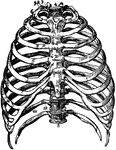
The Bones of the Thorax
Front view of the bones of the thorax, including the ribs, sternum and vertebrae. Labels: 1, first bone…

Scapula
Venter of scapula. Labels: 1, 1, 1, oblique ridges; 2, 2, fossa for subscapularis muscle; 3, superior…
Humerus
Anterior view of humerus (bone of the leg) of the right side. Labels: 1, shaft or diaphysis; 2, the…
Radius
Anterior view of radius (bone of the arm) of the right side. Labels: 1, cylindrical head; 2, surface…
Ulna
Anterior view of the ulna (bone of the arm) of the left side. Labels: 1, olecranon process; 2, greater…
Femur
Posterior view of the femur (bone of the leg). Labels: 1, depression for round ligament; 2, the head;…
Tibia
Anterior view of the tibia (bone of the leg). Labels: 1, spinous process; 2, surface for condyles of…
Fibula
The fibula (bone of leg). Labels: 1, head; 2, articular face; 3, insertion of external ligament; 4,…
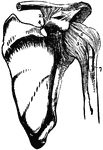
Bones and Ligaments of the Shoulder Articulation
Ligaments of the acromio-clavicular and scapulo-humeral articulations (joints of the shoulder). Labels:…

Back View of the Muscles of the Body
Muscle of the body, back view: The fascia is left upon the left limbs, removed from the right.
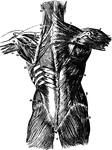
Muscles of the Back
Second layer of muscles of the back. Labels: 1, trapezius; 2, a portion of the ten dinous ellipse formed…
Muscles of the Forearm
Outer layer of muscle on the back of the forearm. Labels: 1, biceps flexor; brachialis internus; 3,…

Deep Muscles of the Hip Joint
Deep-seated muscles on the posterior part of the hip joint. Labels: 1, fifth lumbar vertebra; 2, ilio-lumbar…
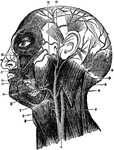
Arteries of the Face and Head
The arteries of the face and head. Labels: 1, common carotid; 2, internal carotid; 3, external carotid;…

Veins of the Legs
Superficial veins of the legs. Labels: 1, saphena major; 2, collateral branch; 3, anastomosis of veins;…
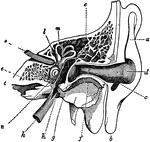
A Cross-Section of the Ear
Cross-section of the external and internal ear. a, b, and c: External ear. d: Entrance…

Teeth of the Upper Jaw
Half of the teeth of the upper jaw. a,a, are the two front cutting teeth. d,d,d are…
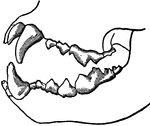
Teeth of a Carnivorous Animal
Teeth of a carnivorous animal that lives on flesh alone. The front teeth are designed for tearing, while…

Teeth of an Herbivore
Teeth of an herbivore, showing the rough surface of some of these teeth. Herbivores have no tearing…
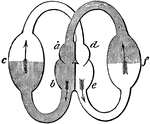
Heart, Compartments of
Diagram showing the compartments of the heart. The smaller compartments are the auricles (also known…
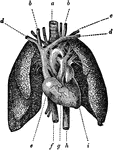
Heart and Lungs
The heart, showing its relative position to the lungs. The heart is almost wholly covered up by the…
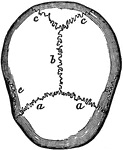
Cranial Sutures
The bones of the top of the head are fastened together by what are called sutures which are locked together…

Upper Two Vertebrae
The upper two vertebrae of the spinal column, involved in head movement. In performing the rotary motion…

Gold Three Dollars Coin, 1854
Three Dollars ($3.00) United States coin from 1854. Obverse has a left-facing indian head with a coronet…

Gold Half Eagle Coin, 1795
Half Eagle ($5.00) United States coin from 1795. Obverse has a right-facing image of Liberty wearing…

Silver Virginia Shilling Coin, 1774
Virginia Shilling (Shilling) Virginia Colony coin from 1774. Obverse has an image of a right-facing…

Silver Dime Coin, 1796
Dime (10 cents) United States coin from 1796. Obverse has the image of a right-facing Liberty with LIBERTY…

Silver Fifth Dollar Coin, 1875
Fifth Dollar (20 cents) United States Coin from 1857. Obverse has the image of Liberty beside a shield…

Silver Quarter Coin, 1853
Quarter (25 cents) United States coin from 1853. Obverse has the image of a Liberty seated beside a…

Silver Half Dollar Coin, 1794
Half Dollar (50 cents) United States coin from 1794. Obverse has the head of Liberty right-facing with…

Silver Half Dollar Coin, 1853
Half Dollar (50 cents) United States coin from 1853. Obverse has the image of a Liberty seated beside…

Silver Half Dollar Coin, 1892
Half Dollar (50 cents) United States coin from 1892. Obverse has the head of Liberty right-facing a…

Silver Columbian Half Dollar, 1892
Half Dollar (50 cents) United States coin from 1892. Obverse has the head of Columbus right-facing with…

Silver Trade Dollar Coin, 1873
Trade Dollar ($1.00) United States coin from 1873. Obverse has a seated, left-facing Liberty holding…

Copper Cent Coin, 1787
New York Cent (1 cent) New York coin from 1787. Obverse has the state coat of arms with the inscription…

Copper Cent Coin, 1785
Pennsylvania Cent (1 cent) Pennsylvania coin from 1785. Obverse has a right-facing image of a head surrounded…

Copper Half Pence Coin, 1773
Virginia Half Pence (half pence) Virginia Colony coin from 1773. Obverse has an image of a right-facing…

War Token, 1863
War token with head with winged cap obverse and eagle with shield reverse. These little mementoes of…

War Token, 1863
War token with femal head and "FOR PUBLIC ACCOMODATION" obverse and eagle reverse. These little mementoes…

War Token, 1863
War token with male head with Phrygian (liberty) cap obverse and "OUR LITTLE MONITOR" reverse. These…

Copper-Nickel Cent Coin, 1859
Cent (1 cent) United States coin from 1859. Obverse has a left-facing Indian head and is inscribed -…

Proportions of a Healthy Child's Body at Birth and Birth and One Year
Proportions of a health child's body and head size at birth and at one year of age.

Proportions of a Healthy Child's Body at 2 and 5 Years of Age
Proportions of a health child's body and head size at 2 and 5.5 years of age.

Thoracic Vertebrae
Two thoracic vertebrae seen from behind, i.e., the end turned from the head. Labels: C, the body; A,…




